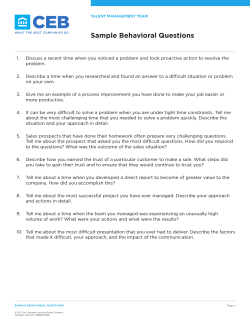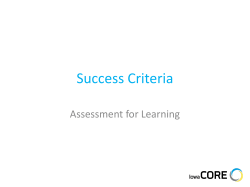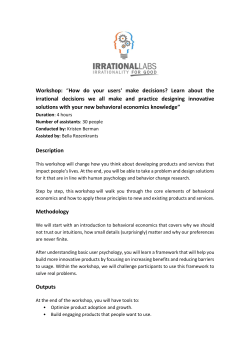
NeuroVR 2 - A Free Virtual Reality Platform for the
NeuroVR 2 - A Free Virtual Reality Platform for the Assessment and Treatment in Behavioral Health Care Giuseppe RIVA 1-3, Andrea GAGGIOLI 1-2, Alessandra GRASSI 1-2, Simona RASPELLI 1, Pietro CIPRESSO 1, Federica PALLAVICINI 1, Cinzia VIGNA1, Andrea GAGLIATI 3 Stefano GASCO 3, Giuseppe DONVITO 3 1 Applied Technology for Neuro-Psychology Lab, Istituto Auxologico Italiano, Milan, Italy 2 Psychology Department, Catholic University of Milan, Italy 3 Virtual Reality & Multimedia Park, Turin, Italy Abstract. At MMVR 2007 we presented NeuroVR (http://www.neurovr.org) a free virtual reality platform based on open-source software. The software allows non-expert users to adapt the content of 14 pre-designed virtual environments to the specific needs of the clinical or experimental setting. Following the feedbacks of the 2000 users who downloaded the first versions (1 and 1.5), we developed a new version – NeuroVR 2 (http://www.neurovr2.org) – that improves the possibility for the therapist to enhance the patient’s feeling of familiarity and intimacy with the virtual scene, by using external sounds, photos or videos. More, when running a simulation, the system offers a set of standard features that contribute to increase the realism of the simulated scene. These include collision detection to control movements in the environment, realistic walk-style motion, advanced lighting techniques for enhanced image quality, and streaming of video textures using alpha channel for transparency. Keywords: Virtual Reality, Assessment, Therapy, NeuroVR, Open Source 1. Introduction The use of virtual reality (VR) in medicine and behavioral neurosciences has become more widespread. This growing interest is also highlighted by the increasing number of scientific articles published each year on this topic: searching Medline with the keyword “virtual reality”, we found that the total number of publications has increased from 45 in 1995 to 3203 in 2010, showing an average annual growth rate of nearly 15%. Although it is undisputable that VR has come of age for clinical and research applications [1-3] the majority of them are still in the laboratory or investigation stage. In a recent review [4], Riva identified four major issues that limit the use of VR in psychotherapy and behavioral neuroscience: • the lack of standardization in VR hardware and software, and the limited possibility of tailoring the virtual environments (VEs); • the low availability of standardized protocols; • the high costs (up to 200,000 US$) required for designing and testing a clinical VR application; • most VEs in use today are not user-friendly. To address these challenges, we presented At MMVR 2007 NeuroVR (http://www.neurovr.org) a free virtual reality platform based on open-source software [5]. The software allows non-expert users to adapt the content of 14 pre-designed virtual environments to the specific needs of the clinical or experimental setting. Following the feedbacks of the 1000 users who downloaded the first version, we developed a new version – NeuroVR 2 (http://www.neurovr2.org) – that improves the possibility for the therapist to enhance the patient’s feeling of familiarity and intimacy with the virtual scene, by using external sounds, photos or videos. 2. NeuroVR 2 Using NeuroVR 2, the user can choose the appropriate psychological stimuli/stressors from a database of objects (both 2D and 3D) and videos, and easily place them into the virtual environment. The edited scene can then be visualized in the Player using either immersive or non-immersive displays. Currently, the NeuroVR library includes 18 different virtual scenes (apartment, office, square, supermarket, park, classroom, etc.), covering some of the most studied clinical applications of VR: specific phobias, cognitive rehabilitation, panic disorders and eating disorders. Specifically, the new version now includes full sound support and the ability of triggering external sounds and videos using three different approaches: the keyboard, timeline or proximity. The VR suite leverages two major open-source projects in the VR field: Delta3D (http://www.delta3d.org) and OpenSceneGraph (http:// www.openscenegraph.org). Both are building components that integrates with ad-hoc code to handle the editing and the simulation.The NeuroVR2 Editor's GUI is now based on the QT cross-platform application and UI framework from Nokia (http://qt.nokia.com/) that grants an higher level of editing and customization over the editor functionalities, while the graphical rendering is done using OpenSceneGraph, an open source high performance 3D graphics toolkit (http://www.openscenegraph.org/projects/osg). All the scenes building can now be done by the therapists using a cleaner and simpler interface, and through a powerful "Action and Trigger" system and an easy to use interface exposed by the editor. The scene creator can now also define how the scene reacts to the patients behavior, when he is using the scene in the VR Player. The NeuroVR2 Player too has been largely rewritten to grant a more efficient workflow for the scenes playback and has a brand new startup interface written in QT. The whole suite is developed in C++ language, targeted for the Microsoft Windows platform but fully portable to other systems if needed. The key characteristics that make NeuroVR suitable for most clinical applications are the high level of control of the interaction with the tool, and the enriched experience provided to the patient. These features transform NeuroVR in an “empowering environment”, a special, sheltered setting where patients can start to explore and act without feeling threatened. Nothing the patient fears can “really” happen to them in VR. With such assurance, they can freely explore, experiment, feel, live, and experience feelings and/or thoughts. NeuroVR thus becomes a very useful intermediate step between the therapist’s office and the real world. Actually, NeuroVR is used in the assessment and treatment of Obesity [6], Alcohol Abuse [7], Anxiety Disorders [1], Generalized Anxiety Disorders [8] and Cognitive Rehabilitation [9; 10]. 3. Conclusions In this chapter, we introduced NeuroVR 2, the new version of an advanced platform designed for the creation and customization of highly flexible VEs for clinical psychology and behavioral neurosciences. A future goal is to provide software compatibility with instruments that allow collection and analysis of behavioral data, such as eye-tracking devices and sensors for psycho-physiological monitoring. Beyond clinical applications, NeuroVR provides the VR research community with a free “VR lab”, which allows the creation of highly-controlled experimental simulations for different of behavioral, clinical and neuroscience applications 4. Acknowledgments The NeuroVR development was partially supported by the European funded project “Interstress” – Interreality in the management and treatment of stress-related disorders (FP7-247685). 5. References [1] A. Gorini and G. Riva, Virtual reality in anxiety disorders: the past and the future, Expert Review of Neurotherapeutics 8 (2008), 215-233. [2] T.D. Parsons and A.A. Rizzo, Affective outcomes of virtual reality exposure therapy for anxiety and specific phobias: A meta-analysis, Journal of Behavior Therapy and Experimental Psychiatry 39 (2008), 250-261. [3] G. Riva and A. Gaggioli, Virtual clinical therapy, Lecture Notes in Computer Sciences 4650 (2008), 90107. [4] G. Riva, Virtual reality in psychotherapy: review, Cyberpsychology & Behavior 8 (2005), 220-230; discussion 231-240. [5] G. Riva, A. Gaggioli, D. Villani, A. Preziosa, F. Morganti, R. Corsi, G. Faletti, and L. Vezzadini, NeuroVR: an open source virtual reality platform for clinical psychology and behavioral neurosciences, Studies in Health Technology and Informatics 125 (2007), 394-399. [6] G. Riva, M. Bacchetta, G. Cesa, S. Conti, G. Castelnuovo, F. Mantovani, and E. Molinari, Is severe obesity a form of addiction? Rationale, clinical approach, and controlled clinical trial, CyberPsychology and Behavior 9 (2006), 457-479. [7] E. Gatti, R. Massari, C. Sacchelli, T. Lops, R. Gatti, and G. Riva, Why do you drink? Virtual reality as an experiential medium for the assessment of alcohol-dependent individuals, Studies in Health Technology and Informatics 132 (2008), 132-137. [8] F. Pallavicini, D. Algeri, C. Repetto, A. Gorini, and G. Riva, Biofeedback, VR and Mobile Phones in the treatment of Generalized Anxiety Disorders: A phase-2 controlled trial, Journal of CyberTherapy & Rehabilitation 2 (2009), 315-328. [9] S. Raspelli, L. Carelli, F. Morganti, B. Poletti, B. Corra, V. Silani, and G. Riva, Implementation of the multiple errands test in a NeuroVR-supermarket: a possible approach, Studies in Health Technology and Informatics 154, 115-119. [10] G. Albani, S. Raspelli, L. Carelli, F. Morganti, P.L. Weiss, R. Kizony, N. Katz, A. Mauro, and G. Riva, Executive functions in a virtual world: a study in Parkinson's disease, Studies in Health Technology and Informatics 154, 92-96.
© Copyright 2025











